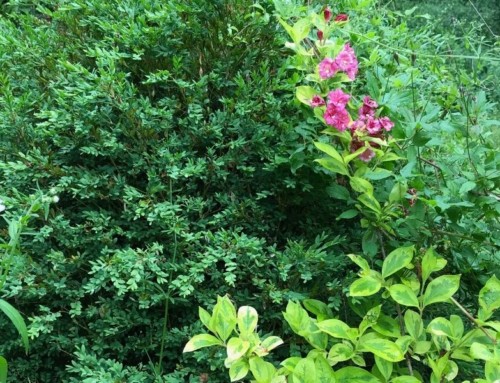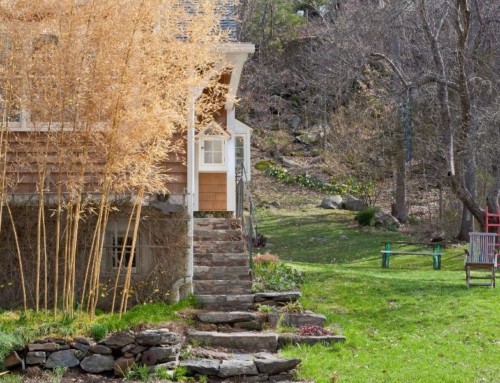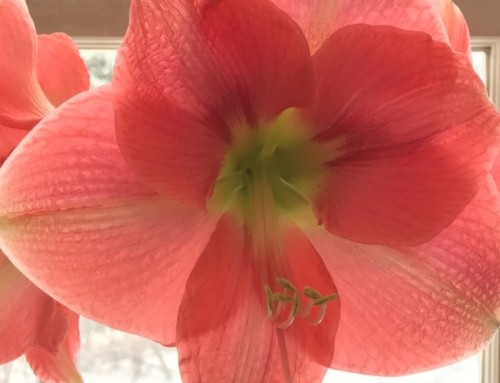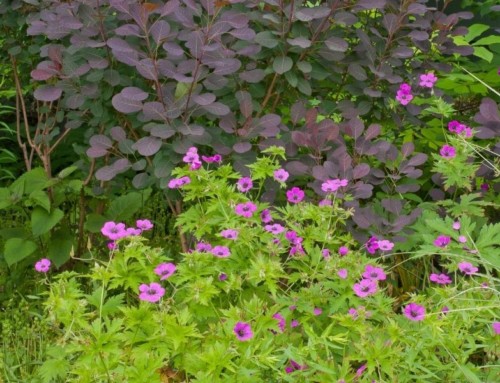If you can’t please yourself in your own garden, where can you? Why put up with plants that just sit there without speaking to each other – or to you?
We grow as gardeners, and our first proud attempts may no longer satisfy. Maybe in the thrill of spring shopping we forgot the rest of the year – easy to do. Prodigal plants can become too much of a good thing or muscle out less enthusiastic reproducers.
Or maybe we just want more exciting plants, something new.
EDITING YOUR GARDEN
This summer I’m having lots of fun editing gardens with my coaching clients and introducing them to perennial plants with pizzazz.
Together we’re learning the difference between having a garden and gardening. Gardening involves love, tweaking, time, observation, change, personality, pleasure – and sometimes ruthless editing.
If a home landscape conveys all the charm and originality of a heavily mulched McDonald’s parking lot (minus cigarette butts), it’s time to fill in with more plants, more color and more contrast to make it more personal and exciting.
TIME FOR TOUGH LOVE
First, get rid of plants you hate, that bore you to tears, get diseased, are invasive, on their last legs or constantly munched by deer. It’s ok to toss plants or share with friends – just don’t send Trojan horses to friends you want to keep.
Do not divide and replant anything you do not love – unless it solves a problem or feeds wildlife in a big way. You can always banish bores to the sidelines if they serve a purpose.
Foliage sticks around all season, so let’s play with leaves. We can still pack our gardens with flowers for pollinators and our own pleasure. The foundation planting pictured above, designed and planted by Ana Hajduk, is a good example of long-lasting color and contrast.
PERENNIALS WITH CHARACTER ADD CONTRAST
Squint your eyes and look at the garden. If everything mushes together, it’s begging for contrast.
We “get it” when something is described as “leaf-shaped.” But if most of your plants are medium green, with similar height, habit and “leaf-shaped” leaves, selecting plants with distinctly different character to play off against them – and each other – will liven things up.
Linear Leaves
- Any grass. Mexican feather grass (Nassella tenuissima) is the ultimate in graceful fine texture. Although not reliably hardy throughout New England, worth planting every year.
- Pennsylvania sedge (Carex pensylvanica) Fine textured native grass lookalike, contrasts beautifully with Christmas ferns in dry shade.
- Soft rush (Juncus effusus) Grass-like evergreen perennial with stiff cylindrical blades, native to wet places, adaptable to gardens. A distinctive silhouette in containers, striking as a mass planting, especially in a rain garden.
Spiky Blade-shaped Leaves
- Yuccas make a bold architectural statement throughout the year, whether their rosettes of spine-tipped swords are silhouetted against stone or snow, standing out in a bed of soft grasses or woven with wandering wildflowers like winecups (Callirhoe involucrata) or sprawling miniature roses.
- Rattlesnake master’s botanical name – Eryngium yuccifolium – suggests its resemblance to yuccas. Like yuccas, it’s tough, drought-tolerant and sends up tall (4-5’) bloom stalks. Clusters of globular inflorescences, comprised of small greenish-white flowers arranged with mechanical precision, are major pollinator attractors.
- Iris blades might not draw blood like yuccas, but their flat pointed leaves make an impact. I would grow mats of woodland crested iris (Iris cristata), fan-shaped Japanese roof iris (Iris tectorum) and upright variegated Iris pallida ‘Aureo-marginata’ even if they never flowered.
Big and Bold Leaves
- Although Rodgersias look (and are) exotic, they add drama to native woodland plantings without seeming out of place. Airy plumes of white, pink or red flowers (depending on species and cultivar) rise above huge, coarsely wrinkled leaves resembling horse chestnut foliage. Flowers are attractive to native bees and butterflies; seedheads remain look good all winter. Foliage fries in full sun; plant in rich, moist soil and dappled shade.
- Give mayapples (Podophyllum peltatum) room to run through the woods. Twin umbrella-like leaves a foot across arise from each stem, with a single white flower tucked below. Bold enough to be appreciated from a distance, that’s where I keep them. These native semi-ephemeral shade lovers go to pieces in late summer, but not before collecting a dazzling display of white bird droppings. I’ve moved them from center stage to wilder areas, where their weed-suppressing colonizing talents out-compete invasive plants.
- Unlike other black-eyed Susans, Rudbeckia maxima, aka large coneflower, has large (8-24”) waxy bluish-greenish-greyish basal foliage that looks like cabbage leaves. Just as they stand out against grasses in their native meadow and prairie habitat, they boost the excitement level in gardens, naturalized areas and rain gardens. Elongated cones surrounded by drooping yellow petals hover on tall (to 8’) nearly leafless stems for a “see-through” effect. A great plant for pollinators and birds alike, and happy in soppy soil, in full sun.
COLORED FOLIAGE
Evergreens aren’t always green, and perennials with colored foliage abound. If a silver-leafed lamb’s ears or artemisia jumps calls to you from the garden center bench, go for it!
Or a dark red, almost black heuchera like ‘Obsidian’, or golden anise hyssop (Agastache foeniculum ‘Golden Jubilee’), blueish-purplish Sedum ‘Vera Jameson’ or chartreuse Sedum rupestre ‘Angelina’. The more the merrier.
The grass may be greener on the other side of the fence, but it’s a lot more fun when grasses and grass look-alikes are blue, yellow or variegated, on yours.
Blue Blades
- Little bluestem (Schizachyrium scoparium ‘The Blues’)
- Helictotrichon sempervirens ‘Sapphire’
- Blue fescue (Festuca glauca ‘Elijah Blue’)
Yellow Blades
- Japanese forest grass (Hakonechloa macra ‘Aureola’ and ‘All Gold’)
- Carex elata ‘Bowle’s Golden’
- Acorus gramineus ‘Ogon’





